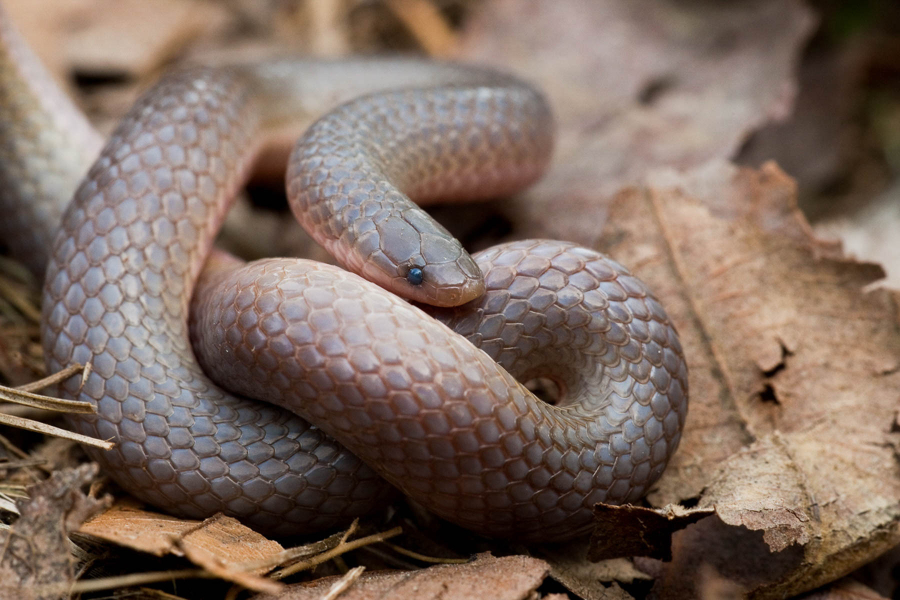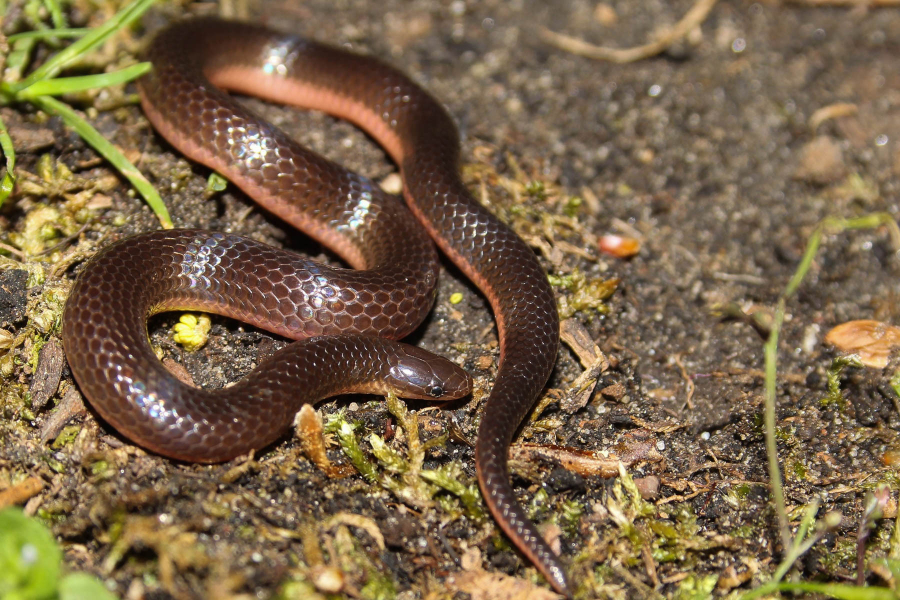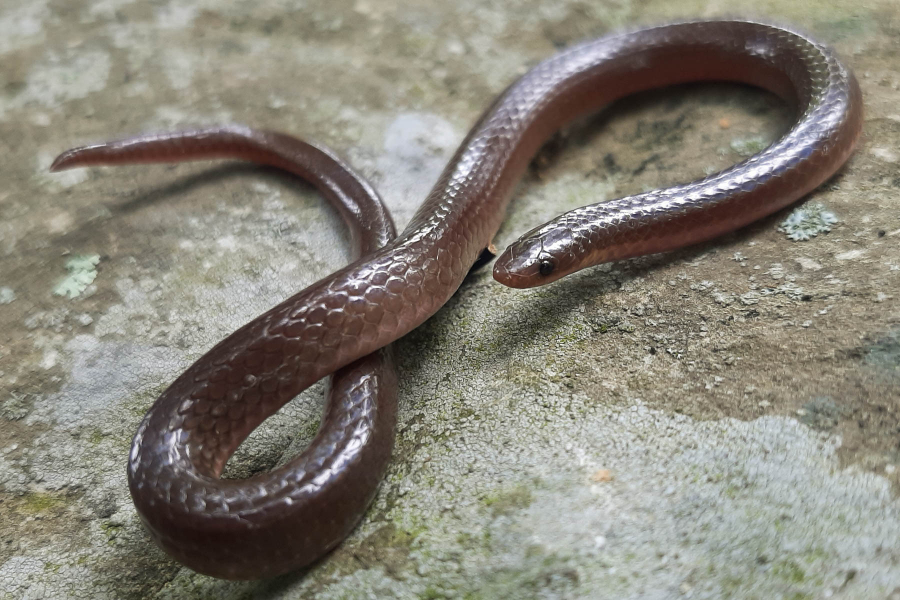Eastern worm snake: worm or snake?
This little brown snake is known for its worm-like appearance

It’s a cool Saturday morning—the perfect time to pick those pesky weeds that have taken over your garden. There, creeping out from below a flowerpot, you spot an abnormally long earthworm. With closer inspection, though, you determine that this tiny wriggling body has scales and eyes. It's not a worm at all, but a snake!
Growing up to 13 inches in length, eastern worm snakes can be found all across the eastern United States, from Southern New England to Central Georgia and as far west as the Mississippi River. These snakes spend their time burrowing in a wide variety of habitats from wetlands and swamps to deciduous woodlands, and other areas with loose soils and leaf litter—like gardens.
If you happen upon a worm snake, don’t be frightened. The eastern worm snake is both blind and, like most species of snake, non-venomous. It defends itself by pressing its pointed tail against predators and releasing a musky smell, which is avoidable if no physical contact is made.
At first glance, it's easy to see why this species is so often mistaken for an earthworm. Both have a pale, brownish-pink coloration and are similar in size and shape. Their bodies are elongated with heads that are indistinguishable from the rest of their body.

With closer examination, though, the differences between the two become more clear. Unlike the earthworm that has only a thin layer of skin, the eastern worm snake has 13 rows of small, smooth scales covering its entire body and a dark, pointed tail.
Even though eastern worm snakes hatch with zero vision, they still have small, black rounded eyes that sit on either side of their heads. Earthworms, on the other hand, are eyeless, instead using light receptors to navigate.
Since eastern worm snakes have backbones and earthworms do not, the biggest distinction between the two animals is their movement. Those vertebrae allow the snake to swiftly slither through various terrain. Earthworms are known for much slower movement, using “setae” (small bristles covering their body) to anchor their posterior and extend their muscles to move forward.
Ironically, the eastern worm snake actually preys primarily on earthworms. When worms are unavailable, this little snake will settle for slugs, spiders, snails and caterpillars. Because they can’t see, eastern worm snakes must rely on their other senses when hunting for food. When the snake catches the scent of its prey, it enters predator mode and begins tracking. Once close enough to its target, the snake will swallow it whole.

While the eastern worm snake spends most of its time hidden, it is still highly susceptible to predation. Large lizards and snakes, birds and small mammals pose the greatest threat. To escape these predators, the eastern worm snake initiates a variety of survival tactics such as burrowing beneath rocks or leaf litter, attempting to flee or camouflaging itself.
When worm snakes aren't escaping the heat, hunting for food or hiding from predators, you can find them protecting their eggs. Mating season begins in late spring and continues throughout the summer. Throughout July, female eastern worm snakes will scope out depressions under rocks and rotting logs to safely lay two to eight eggs. Until the eggs hatch in late August, females will spend 75% of their time guarding them from predators.
Have you spotted an eastern worm snake while on a hike or in your garden? Let us know in the comments!

Comments
I saw one today in Bronx, NY near the woods along the north bank of the Harlem River. I thought it was a worm at first, but it was too dark and moved too quickly on the cement to be a worm.
Yes, I see them atleast 3-4 times a week in my yard in Northern TN. Wasn’t sure what they were till I googled them and found out. Thought they were just large worms.
Found one yesterday under leaves wanna keep as a pet
My cat bought somewhere I found under pile of toilet paper dead one. Cat plays with toilet paper in the bathroom. Hopefully they do not live inside sewage system. Not sure. I actually saw some snakes in tennis in Kazakhstan which lived inside the toilets
We were coming home last evening and one was on our walkway just outside our patio door. I knew immediately what it was. I touched it and it wiggled around until it found the side of the concrete walkway and slithered into the rocks below.
06/27/2024 Swoyersville, Pa. found one while weeding my garden. First thought it was a long worm but by the movement I realized it was a snake.
Found one today and had one a couple years ago. Easy to identify. I live in Moore, Ok.
We live in the woods in central VA. We've seen 2 so far this spring. Super fast little guys!
Cutting grass yesterday and came across what had to be a worm snake. Thought it was a long fast moving worm and noticed the head was darker.
I found what I think is an Eastern worm snake but it seems like it has feet it's walking on and I'm a little confused and I don't know what to do and there's a lot of them. It's a boundary that was under a pail. I used to catch water. What should I get rid of them? What should I do with
Found 3 what I believe is the eastern worm snake under cinder blocks that I was moving in upstate South Carolina.
Disturbed what I believe to be an Eastern Worm Snake today while weeding. Bayfield, WI
Found a worm snake in my backyard Saturday under a concrete paver.
Hi Lewis, not to our knowledge, but that would be a great idea.
"Ironically, the eastern worm snake actually preys primarily on earthworms." Has there been any studies about the relationship between areas with a healthy population of of Worm Snakes and Asian Jumping Worms?
Thank you!
Your comment has been received. Before it can be published, the comment will be reviewed by our team to ensure it adheres with our rules of engagement.
Back to recent stories